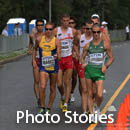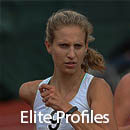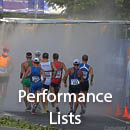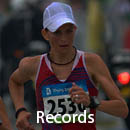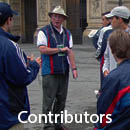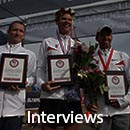MARCO EVONIUK
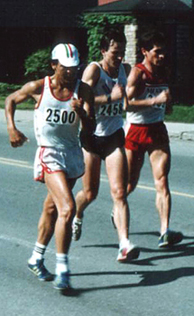
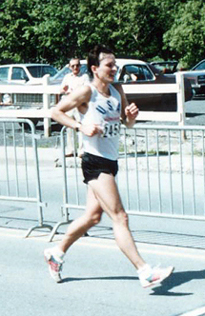
Birthday: September 30th, 1957
Current Residence : San Francisco, CA
Hometown: Longmont, CO
College: University of Colorado
PRS
Outdoors
20 km - 1:25:23
50 km - 3:56:55
Distance great Marco Evoniuk actually started his athletic career as a high school sprinter, running the 220 in 22.8 and the 440 in 50.5; but his destiny was elsewhere. Growing up in the strong amateur track community of Colorado, in 1976 Evoniuk was lured into race walking by two Centurion race walkers. While we very rarely hear of Centurion walkers today, like the Jedi Knights, they once were plentiful.
Dr. Amaroso and the late Chuck Hunter took Evoniuk in as their padawan learner during his senior year of high school. Evoniuk quickly became quite serious about his training. In no time at all, he was race walking distances—long distances. With strong family support behind him, he excluded everything except his studies. He recognized that as a sprinter without a distance base, he needed to train hard. Feeling he needed a diverse training program, he combined running and walking workouts to master the distance and form of race walking.
On Saturdays, Evoniuk chased master's running-great Bob Green for about 12 miles, running 5:30 per mile while Green smoked him. On Sundays, Evoniuk joined the Centurions. Battered from his runs, he typically ambled 20-mile walks at a 10-minute pace. "I couldn't go any faster," remembers Evoniuk.
In all, Evoniuk ran and walked for a combination of approximately 70 to 90 miles per week. With the exception of his weekly distance day with the Centurions, Evoniuk didn't believe in Long Slow Distance (LSD) workouts. "I just go fast, everyday," Evoniuk recalls. He felt this training approach worked best for him, perhaps because of his sprinting background. Racing whenever he could—practically every weekend—Evoniuk bounced between racing at high school all-comer meets to race walking a series of 10K running competitions in the Denver area.
These races must not have been enough of a challenge, because soon Evoniuk ran the Denver marathon (finishing in 2:40), "Just to build confidence." He soon taught his mentors who the new master was.
In 1977 Evoniuk finished second at the 100K National Championships with a time of 11:19. While finishing second in such races represents a significant achievement, to be a true master of the sport, Evoniuk needed to succeed at the Olympic distances of 20K and 50K. His big breakthrough came in 1978, when he finished fifth at the U.S. 20K Nationals at UCLA to qualify for his first international race, the Swedish Walk in June.
The international experience really helped Evoniuk mature as a competitor. Placing at national competition provided little challenge for the upstart: the very first time he raced the 50K Nationals, he won. Still a relative unknown in 1978, he took most of the 50K field by surprise. After Nationals, in typical Evoniuk style, he drove all night to join a training camp with the top Mexican race walkers. Gaining international exposure with the likes of Mexican walking greats Daniel Bautista and Raul Gonzales added to his confidence.
By the end of the seventies, Evoniuk knew he had made it and could compete with the best in the U.S. Late in the race at the 1980 Olympic Trials, he dueled it out with Jimmy Heiring along a hilly Eugene, Oregon course. The judges really held the two competitors down, and they entered the stadium together. With nothing truly on the line because of the Olympic boycott, in the end, they decided to finish in a tie. Evoniuk, ever the optimist, figured he could do it all again in 1984.
En route to the next Olympics, the World Championships in Helsinki furthered Evoniuk's fortitude. Finishing 9th against the world’s top walkers—and under very hot conditions—his confidence rose to an all-time high. By the time he became a resident at the Olympic Training Center in 1983, Evoniuk was at the top of his game. His goal was no less than medaling at the 1984 Olympic Games. Considering himself better at the 50K than 20K, he believed the boycott by the Soviet Union and other Eastern Block countries only improved his chances. Accomplishing a lot at the Center, Evoniuk remembers "working hard and having some fun." Although Evoniuk claims to have missed a lot of the fun, he loved to play the prankster. One day he showed up to training with bleached orange hair, driving a different car, "just to do things to make it interesting."
Evoniuk won both Olympic Trial races in an impressive way. With oppressive heat each day, Evoniuk set the stage with a 10-minute victory at the 50K. At first it looked like a double triumph was out of the question. However, after Jimmy Heiring built up a huge lead, his knee problems forced him to fade. Evoniuk not only won the 20K, but also set an Olympic Trials 20K record that stood until 2000.
Evoniuk's Olympic experience was eventful—and not just because he was competing in two events. While out on the town, he and Mike Morris participated in another form of walking: jay walking. Apparently the L.A. police didn't find Evoniuk and Morris' antics amusing and escorted them downtown "to get it taken care of." With such distractions behind him, Evoniuk got down to business.
Conditions were hot, but Evoniuk liked it hot. He finished 7th in the 20K. However, being a 50K specialist, he wondered if he should have competed in the shorter race. He had only one week to recover before the 50K event, and while he felt physically recovered, he felt mentally unprepared to put it together for his favorite event.
To this day, Evoniuk doesn't know what happened during the 50K. He believes it was not the pressure: he had raced too much for that to be a factor. Basically, he felt unable to regain his focus and dropped out of the race early. He "just couldn't get going again" after the 20K, he recalls.
Typical of a post-Olympic Year, 1985 was a down time for Evoniuk. But at the start of 1986, he began a multi-year training cycle with the aim of taking another shot at an Olympic Medal. Building a solid fitness level, Evoniuk felt the key was to increase speed. He never did LSD. He used the 20K as a tool for good leg speed, but put little importance on the National Championships at this distance. He believed they were too early in the season. Instead, he focused on international competition. Amazed by the likes of Ron Laird and Tim Seaman competing in so many national championships, he regarded the key, instead, as focusing on a single goal.
Evoniuk's plan succeeded. At the 1988 Olympic Games in Seoul, he set a new American record. Unfortunately, the plans of his international competitors also succeeded. With race walkers across the world growing faster, Evoniuk finished further back in the pack. By his third Olympic Games in 1992, one might expect him to have the routine down. However, although he trained well leading up to the race, Evoniuk just could not get moving. He dropped out of the race, his last Olympic appearance.
For all his success, his inconsistency in international competition plagued Evoniuk throughout his career. He believes there were just too many races over too many years to stay focused. Looking back, he remains amazed he was able to maintain focus across such a long period of time.
Evoniuk continued to work hard, but the next generation of walkers gained prominence. In time he found it "so much more difficult to do the distance." He felt his workout recovery time increasing and his body wearing out. Still, without the pressure of being on top, he experienced the fun of his sport once again.
No longer competing, today Evoniuk runs, walks, and lifts weights to stay in shape. He is glad the days of extreme mileage are over! He now works as a financial planner in San Francisco, California.
1992
9th - 1:29:57
1990
3rd - 1:28:21
1989
4th - 1:28:22
1988
3rd - 1:31:12
1986
7th - 1:30:43t
1985
2nd - 1:28:40
1984
1st - 1:25:13
1983
2nd - 1:27:07
1982
3rd - 1:25:30
1981
4th - 1:26:40
1980
1st - 1:26:51
1979
7th - 1:32:22
1978
5th - 1:34:11
1998
6th - 4:20:13
1997
4th - 4:16:59
1996
4th - 4:10:45
1995
4th - 4:11:31
1992
3rd - 4:09:44
1991
2nd - 4:04:46
1990
2nd - 4:16:28
1988
1st - 3:56:55
1987
1st - 3:57:43
1986
1st - 4:05:56
1985
1st - 4:11:03
1984
1st - 4:02:25
1983
8th - 4:15:56
1982
1st - 4:03:13
1981
1st - 4:07:44
1980
1st - 4:00:30
1979
5th - 4:10:33
1978
3rd - 4:24:05
None
1986
50K - 4:13:31.7
1984
20K Olympic Trials - 1:26:17
50K Olympic Trials - 4:02:25
1984
30K - 2:16:41
1984
35K - 2:48:08
1983
50K - 4:01:43
1980
20K Olympic Trials - 1:27:12 (tie for 1st)
1980
50K - 4:24:05
1979
50K - 4:15:07
1977
1 hour - 7 miles, 399 yards
20K Olympic Games
1984 - 7 th - 1:25:42 - Los Angeles, USA
50K Olympic Games
1992 - DNF - Seoul, Korea
1988 - 22 nd - 3:56:55 - Seoul, Korea
1984 - DNF – Los Angles, USA
50K World Cup
1997 - 68 th - 4:17:24 - Podebrady, Czechoslovakia
1995 -47 th - 4:11:31 - Beijing, China
1991 - DNF - San Jose, USA
1987 - DNF - New York City, USA
1985 - 16 th - 4:11:03 - St. John's, Isle of Man
1983 - DQ - Bergen, Norway
1981 - 13 th - 4:07:44 - Valencia, Spain
1979 - 35 th - 4:12:37 - Eschborn, West Germany
20K World Championships
1983 – DNF - Helsinki, Japan
50K World Championships
1987 - 17 th - 3:57:43 - Rome, Italy
1983 - 9 th - 3:56:57 - Helsinki, Japan
50K Pan Am Cup
1998 5 th - 4:36:53 - Miami, USA
1996 8 th - 4:40:18 - Manaus, Brazil
1988 DNF - Mar del Plata, Argentina
1986 2 nd - 4:05:56 - St. Leonard, Canada
20K Pan Am Games
1983 – DNF – Caracas, Venezuela
50K Pan Am Games
1991 - DNF - Havana, Cuba
1979 3 rd - 4:24:23 - San Juan, Puerto Rico
